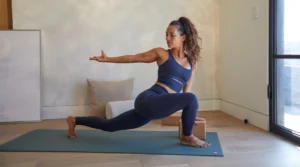Introduction to Breathwork
Imagine you’re sitting in a quiet room, feeling the weight of a stressful day pressing down on you. Your heart races, your mind spirals, and then you take a slow, deep breath. Suddenly, the world feels a little lighter. Breathwork, the practice of consciously controlling your breathing patterns, is more than just a wellness trend—it’s a science-backed tool for managing stress and enhancing well-being. From ancient yogic practices to modern clinical studies, breathwork has emerged as a powerful way to calm the mind and body.
What Is Breathwork?
Defining the Practice
Breathwork refers to a variety of techniques that involve intentional control of breathing to influence physical, mental, and emotional states. It ranges from simple deep breathing to structured practices like cyclic sighing or box breathing. These methods are designed to regulate the body’s stress response and promote relaxation.
A Brief History
Breathwork isn’t new—it’s rooted in ancient traditions like yoga, Tai Chi, and meditation, where breath was seen as a bridge between body and mind. Today, science is catching up, validating what spiritual leaders have known for centuries: your breath can be a gateway to calm.
The Science of Stress and the Body
How Stress Affects Us
Stress triggers the body’s fight-or-flight response, flooding your system with cortisol and adrenaline. Your heart rate spikes, breathing becomes shallow, and muscles tense. Chronic stress can lead to anxiety, depression, and even physical ailments like high blood pressure.
The Role of the Autonomic Nervous System
The autonomic nervous system (ANS) governs involuntary functions like heart rate and breathing. It has two branches: the sympathetic (fight-or-flight) and the parasympathetic (rest-and-digest). Breathwork taps into the parasympathetic system to counter stress, promoting a state of calm.
How Breathwork Reduces Stress
Activating the Parasympathetic Nervous System
Slow, deliberate breathing stimulates the vagus nerve, a key player in the parasympathetic nervous system. This activation slows heart rate, lowers blood pressure, and signals the body to relax. A 2023 study found that just five minutes of breathwork can significantly reduce physiological arousal.
Regulating Cortisol and Hormones
Breathwork also helps balance stress hormones. By reducing cortisol levels, it prevents the harmful effects of chronic stress. Research shows diaphragmatic breathing can lower cortisol in healthy adults, improving mood and reducing anxiety.
Enhancing Vagal Tone
Vagal tone refers to the strength of the vagus nerve’s activity. Higher vagal tone is linked to better emotional regulation and stress resilience. Techniques like cyclic sighing, with prolonged exhalations, increase vagal tone, making you feel calmer over time.
Key Breathwork Techniques for Stress Reduction
Cyclic Sighing
Cyclic sighing involves deep inhalations followed by extended exhalations. A 2023 Stanford study found it more effective than mindfulness meditation for improving mood and reducing anxiety, with participants reporting significant stress relief after just one month.
Box Breathing
Popular in high-stress professions like the military, box breathing involves equal counts of inhaling, holding, exhaling, and holding again (e.g., 4-4-4-4). It’s a structured way to calm the mind and body, ideal for quick stress relief.
Diaphragmatic Breathing
Also called belly breathing, this technique emphasizes deep breaths that engage the diaphragm. Studies show it improves oxygen saturation and reduces blood pressure, making it effective for both mental and physical health.
Physiological Sigh
This technique, popularized by neuroscientist Andrew Huberman, involves two quick inhales through the nose followed by a long exhale. It’s a rapid way to reset the nervous system during acute stress, often taking just seconds to work.
The Benefits of Breathwork
Physical Benefits
Breathwork doesn’t just calm the mind—it transforms the body. Here’s how:
- Improved Oxygenation: Deep breathing enhances oxygen delivery to cells, boosting energy and vitality.
- Lower Blood Pressure: Slow breathing activates baroreceptors, reducing blood pressure.
- Enhanced Heart Rate Variability (HRV): Higher HRV indicates a healthier cardiovascular system and better stress resilience.
Mental and Emotional Benefits
The mental perks are just as compelling:
- Reduced Anxiety: Breathwork lowers anxiety by calming the amygdala, the brain’s fear center.
- Improved Mood: It triggers the release of endorphins and serotonin, fostering feelings of joy.
- Better Focus: Slow breathing increases alpha brainwave activity, enhancing mental clarity.
Comparison: Breathwork vs. Meditation
| Aspect | Breathwork | Mindfulness Meditation |
|---|---|---|
| Focus | Active control of breath | Passive observation of thoughts |
| Time to Effect | Immediate (5-10 minutes) | Gradual (weeks to months) |
| Ease of Learning | Simple, beginner-friendly | Requires practice for mastery |
| Physiological Impact | Direct vagus nerve stimulation | Indirect calming via mental focus |
| Best For | Quick stress relief, high-stress settings | Long-term mindfulness, emotional awareness |
Breathwork often outperforms meditation for rapid stress reduction, as shown in a 2023 study comparing cyclic sighing to mindfulness meditation.
Real-Life Examples of Breathwork in Action
A Soldier’s Story
Jake, a U.S. Marine Corps officer, faced a life-or-death moment when his vehicle hit an explosive device in Afghanistan. Amid chaos, he used a breathing exercise to stay calm, tourniquet his injuries, and save his life. His story highlights breathwork’s power in extreme stress.
Everyday Stress Relief
Sarah, a busy mom, struggled with anxiety until she tried box breathing during her commute. “It’s like hitting a reset button,” she says. Five minutes of 4-4-4-4 breathing helped her feel grounded, showing how breathwork fits into daily life.
Pros and Cons of Breathwork
Pros
- Accessible: Requires no equipment and can be done anywhere.
- Cost-Effective: Free to learn and practice.
- Quick Results: Effects can be felt in minutes.
- Versatile: Suitable for all ages and fitness levels.
Cons
- Requires Practice: Some techniques, like cyclic hyperventilation, need guidance to avoid discomfort.
- Not a Cure-All: May not replace therapy for severe mental health issues.
- Time Commitment: Daily practice is needed for long-term benefits.
People Also Ask (PAA) Section
What is the science behind breathwork?
Breathwork influences the autonomic nervous system, particularly the parasympathetic branch, by stimulating the vagus nerve. This reduces heart rate, lowers cortisol, and promotes relaxation. Studies show it also increases heart rate variability, enhancing stress resilience.
How does breathwork reduce stress?
By slowing breathing and extending exhalations, breathwork activates the “rest-and-digest” response, calming the body and mind. Techniques like cyclic sighing have been shown to reduce physiological arousal and improve mood more effectively than meditation.
Can breathwork help with anxiety?
Yes, breathwork is clinically effective for anxiety. A 2023 scoping review found significant improvements in anxiety symptoms among adults with diagnosed disorders, making it a viable treatment option.
What are the best breathwork techniques for beginners?
Beginners should start with diaphragmatic breathing or box breathing. Both are simple, safe, and effective for reducing stress without requiring advanced training.
How to Get Started with Breathwork
Where to Learn Breathwork
- Online Courses: Platforms like Breatheology offer free and paid courses to master techniques like cyclic sighing.
- Apps: Apps like Calm or Breathwrk provide guided sessions for beginners.
- Local Workshops: Search for breathwork facilitators near you through sites like Breathing Space.
Best Tools for Breathwork
- Breathwrk App: Offers guided exercises for stress relief.
- Insight Timer: Includes free breathwork meditations.
- Oura Ring: Tracks HRV to monitor breathwork’s impact on your body.
Step-by-Step Guide to Cyclic Sighing
- Sit comfortably with your back straight.
- Inhale deeply through your nose for 4 seconds.
- Take a quick second inhale to fully expand your lungs.
- Exhale slowly through your mouth for 6-8 seconds.
- Repeat for 5 minutes daily.
Integrating Breathwork into Daily Life
Morning Routine
Start your day with five minutes of diaphragmatic breathing to set a calm tone. It’s a simple way to boost energy and focus before tackling your tasks.
During Stressful Moments
When stress hits, try the physiological sigh. Two quick inhales followed by a long exhale can reset your nervous system in under a minute, perfect for high-pressure situations.
Before Bed
Practice box breathing to unwind. It lowers heart rate and prepares your body for restful sleep, reducing nighttime anxiety.
The Future of Breathwork Research
Emerging Studies
Researchers are exploring breathwork’s potential for conditions like PTSD, epilepsy, and even stroke recovery. A 2023 study suggests diaphragmatic breathing improves cognitive and motor functions in stroke patients.
Gaps in Knowledge
While promising, breathwork research is still young. Future studies need larger sample sizes and long-term data to fully understand its effects, especially for clinical populations.
Breathwork for Specific Populations
High-Stress Professions
First responders, soldiers, and healthcare workers benefit from box breathing’s quick calming effects. Its structured nature suits fast-paced environments where focus is critical.
Chronic Illness
Patients with asthma or heart failure can use diaphragmatic breathing to improve oxygen saturation and reduce symptoms, as shown in a 2020 study on congestive heart failure.
Mental Health
Breathwork is gaining traction in therapy, often paired with CBT or somatic experiencing. It’s particularly effective for trauma, helping release stored emotional tension.
Common Myths About Breathwork
Myth: It’s Just Hyperventilation
Unlike uncontrolled hyperventilation, breathwork uses deliberate patterns to regulate the body. Techniques like cyclic sighing avoid the risks of over-breathing.
Myth: It’s Only for Yogis
Breathwork is for everyone, not just spiritual practitioners. From athletes to CEOs, its benefits are universal and backed by science.
FAQ Section
Is breathwork safe for everyone?
Most breathwork techniques are safe, but those with respiratory or cardiovascular conditions should consult a doctor. Avoid intense methods like cyclic hyperventilation without guidance.
How long does it take to see results?
Many feel calmer after one session, but consistent practice (5-10 minutes daily) yields lasting benefits, like improved mood and stress resilience, within a month.
Can breathwork replace medication?
Breathwork complements but doesn’t replace medication for serious conditions. Always consult a healthcare provider before making changes to treatment plans.
What’s the best time to practice breathwork?
Anytime works, but morning sessions boost energy, midday breaks reduce stress, and evening practices promote sleep. Consistency matters more than timing.
Does breathwork improve physical health?
Yes, it enhances oxygen delivery, lowers blood pressure, and improves HRV, supporting cardiovascular and respiratory health.
Conclusion: Breathing Your Way to Calm
Breathwork is more than a wellness buzzword—it’s a scientifically validated tool for taming stress and reclaiming balance. Whether you’re a busy parent like Sarah or a soldier like Jake, your breath is always with you, ready to anchor you in moments of chaos. By practicing techniques like cyclic sighing or box breathing, you can tap into your body’s natural ability to relax and thrive. So, take a deep breath, and let the science of breathwork guide you to a calmer, healthier you.
External Resources
- Breatheology Courses for structured breathwork training.
- Transformational Breath Foundation for research and facilitator resources.
- Huberman Lab Podcast for insights on the physiological sigh.







